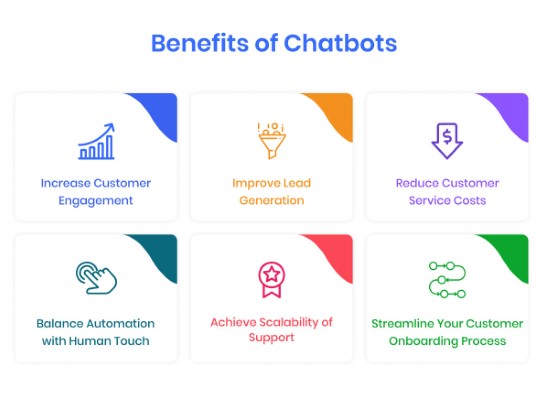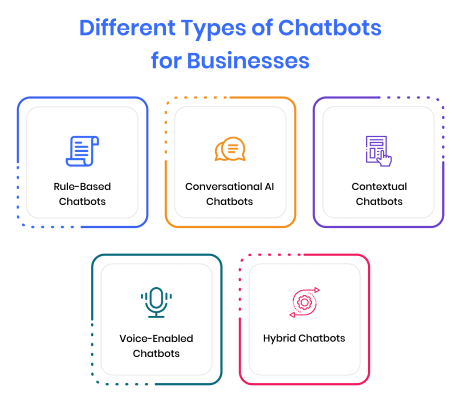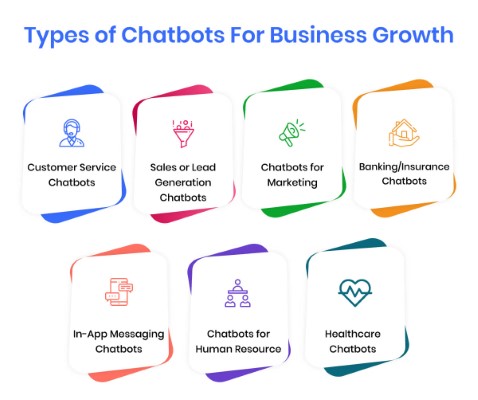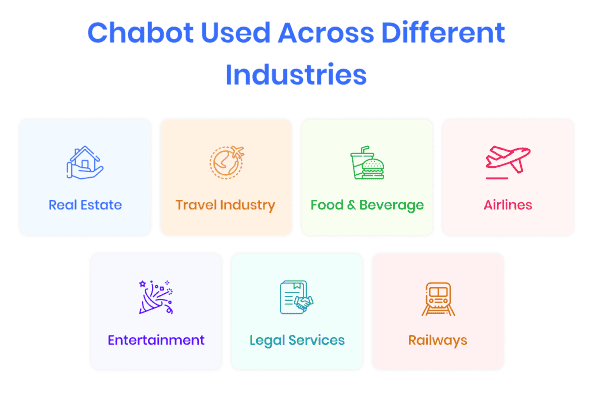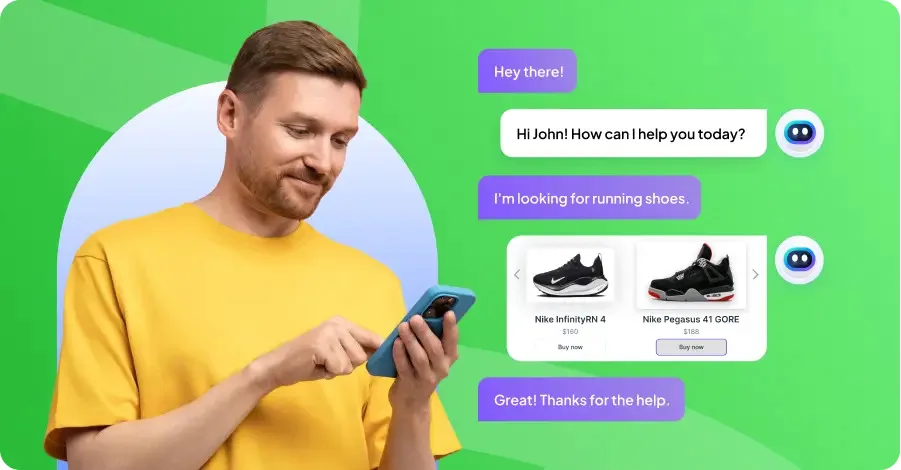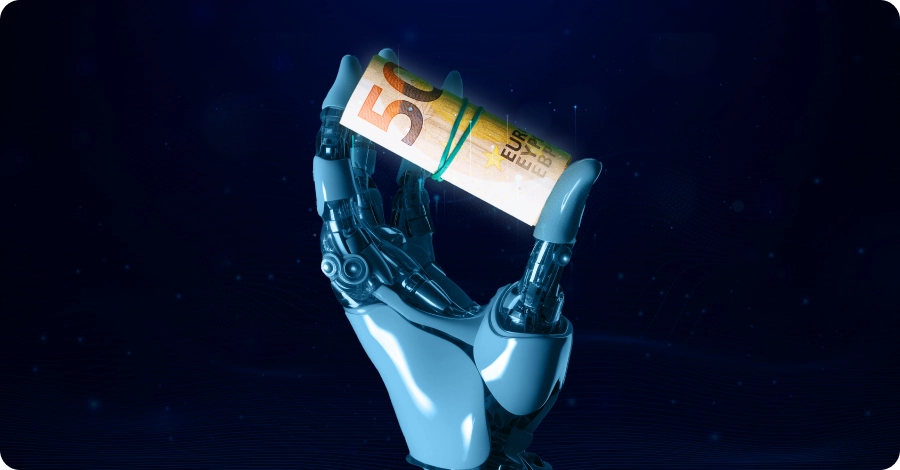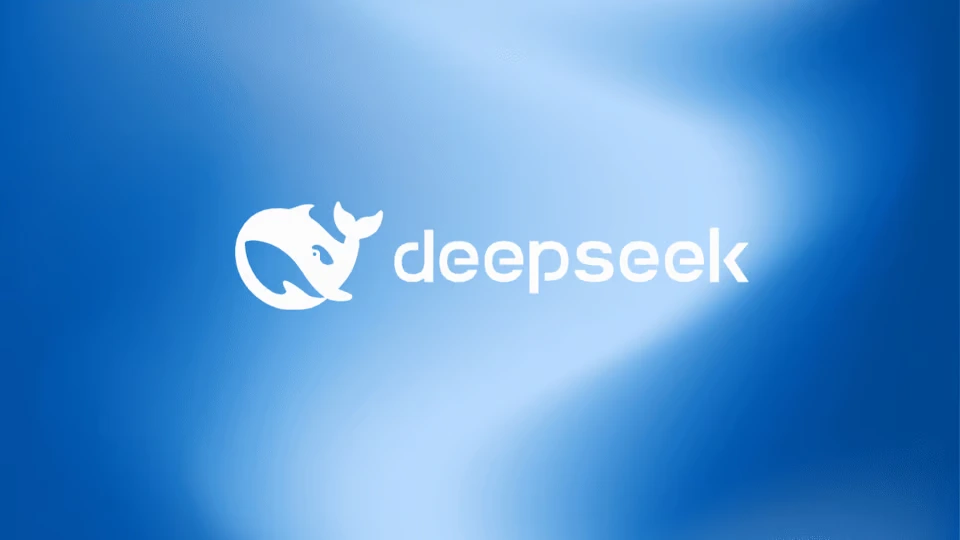6 Types of Chatbots & How to Choose One for Your Business
- November 7, 2022
- 21 mins read
- Listen
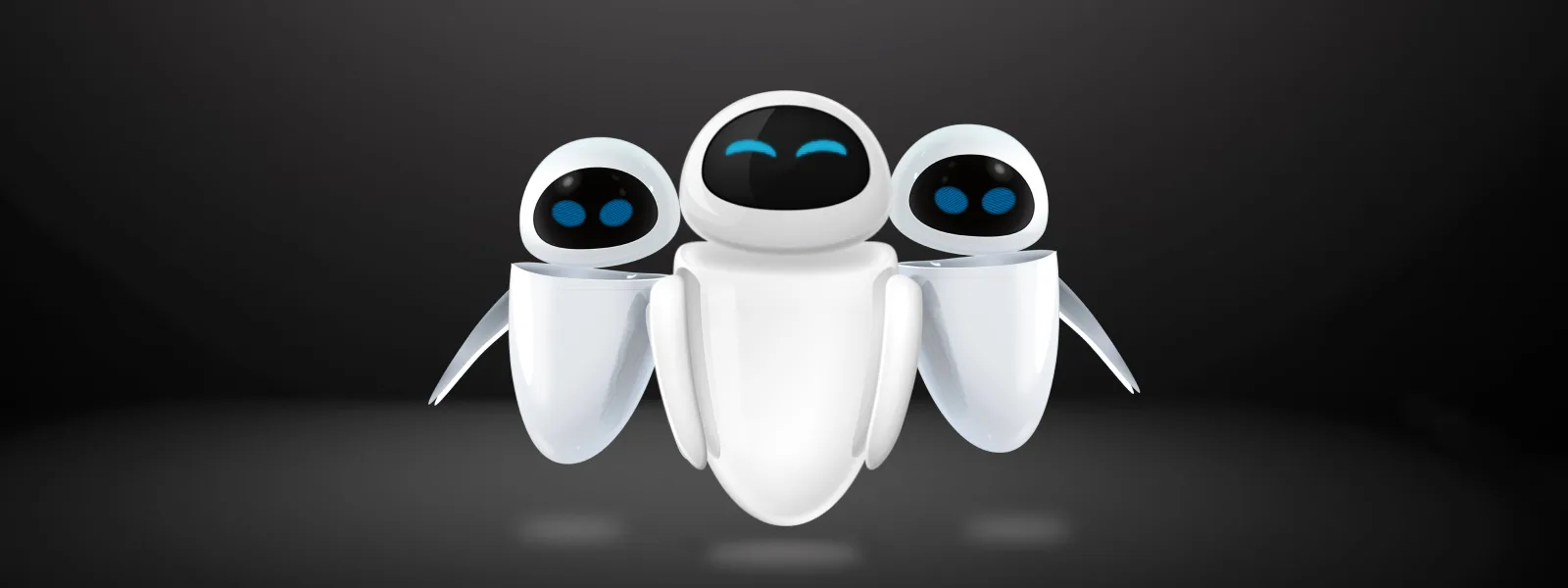
Table of Content
Customers need instant assistance 24/7 but companies that cannot provide such services don’t survive for too long in the business. They face increasing pressure to deliver quick, personalized, and efficient customer service. Long wait times in the queue, repetitive queries, and the need for round-the-clock support can become overwhelming for businesses and also frustrating for customers. These pain points lead to dissatisfaction among customers, loss of potential leads, and a decline in brand loyalty.
That’s where chatbots step in as a solution, specifically designed to close the gap between businesses and their customers. They have become so popular that the global chatbot market is going to reach $9.4 billion. Thousands of companies worldwide, from SMBs to enterprises all are developing various types of chatbots that focus on accelerating their customer experience and curtailing support costs.
You might be wondering how many types of chatbots are there. There are hundreds of types of chatbots but the classification of chatbots depends on two main things:
- Business Use Cases – the problem you are trying to solve
- Chatbot Functionalities – the features you are trying to incorporate
In the article below, we will help you understand the different types of chatbots, what these are used for, and what type of chatbot technology could have the biggest value for your business.
What is a Chatbot?
‘A chatbot is a conversational tool designed to comprehend customer inquiries and provide automated responses often through text or voice.’
You can program these bots to automate simple tasks, answer common questions, or assist with more complex issues, depending on their level of sophistication.
Let’s look at a scenario- Imagine a customer visits an eCommerce website at midnight, and wants some instant assistance related to some product features. Instead of waiting to get assistance from a live chat agent, he can easily interact with a chatbot that instantly provides the required details. These chatbots, depending on the level of advanced technologies and pre-configuration, can handle various repetitive queries without human intervention.
When powered by advanced conversational AI, these chatbots take things one step further. Conversational AI bots use Natural Language Processing (NLP) and machine learning to understand the intent behind a customer’s message and offer more personalized services. In this case, a conversational AI bot can not only provide the customer with product details but also recommend the best options based on his purchase history.
Benefits of Chatbots for Your Business
Businesses deploy different types of chatbots based on their use cases starting from streamlining the business processes to enhancing customer engagement and increasing productivity. Bots help to convert users to customers, drive sales, and improve the overall consumer experience.
Let’s take a look at the key advantages of a chatbot.
-
Increase Customer Engagement
Bots can deliver quick answers by being 24×7 available which encourages customers to stay longer on your website and maintain the conversation.
-
Improve Lead Generation
Businesses can use chatbots for lead generation to guide customers in making quick decisions. Bots use a preset questionnaire to persuade visitors for lead generation and ensure higher conversion rates.
-
Reduce Customer Service Costs
Implementing chatbots is an investment to optimize customer service costs. Bots can save you extra costs that otherwise go into hiring more support resources, infrastructure, training, etc.
-
Balance Automation with Human Touch
You can understand the difference between chatbot vs live chat and try to integrate them together for better customer service. The smooth transition between chatbot to live chat provides real-time responses to the customers, giving them the best hybrid experience.
-
Achieve Scalability of Support
Chatbots are easily scalable to effectively handle peak hours without the need to add more support reps or other costs. hey efficiently manage high inquiry volumes during peak times without requiring a large team, which reduces operational costs and allows human agents to focus on complex issues.
-
Streamline Your Customer Onboarding Process
Customers like to be guided no matter how many support tutorials you offer them. Chatbots prove to be handy to educate customers and ease the onboarding process. Despite the availability of support tutorials, customers often seek personalized guidance to fully understand a product or service. Chatbots work wonders here, providing step-by-step assistance and answering common questions in real-time.
What are the Different Types of Chatbots?
A chatbot deployed on the eCommerce website would be totally different from the one implemented on the banking site. Just as humans contrast in personality, traits, or capabilities, the same goes for chatbots.
Here we will discuss what are the different types of chatbots, their applications, and their functionalities. It will give you a fair understanding of chatbot classification and what would be the ideal chatbot type for your business.
So, let’s dive in.
1. Menu/Button-Based Chatbots
These bots are the simplest type of all chatbots, guiding users through various predefined options that are presented as buttons or menus. Instead of typing out the questions or requests, users are given available choices as a form of buttons to navigate through the conversation. These bots are useful for automating tasks like answering FAQs, placing orders, or handling basic customer service inquiries.
However, these button-based bots struggle with more complex scenarios where there are numerous variables involved, making it difficult to guide users towards the right answers. Additionally, menu/button-based chatbots tend to be the slowest of all bots in helping users get their required information.
2. Rule-Based Chatbots
Rule-based chatbots also referred to as decision-tree bots, use a series of defined rules. These rules are the basis for the types of problems the chatbot can be familiar with and deliver solutions for. Like a flowchart, rule-based chatbots map out conversations.
Rule-based or scripted are the types of chatbots that can be used to answer common questions – for instance, booking a table in a restaurant or buying tickets to the cinema. Followed by a decision tree, the customers are provided a set of predefined options that lead to the relevant answer.
3. Conversational AI Chatbots
AI-enabled chatbots combine the power of Machine Learning (ML) and Natural Language Processing (NLP) to understand the context and intent of a question before formulating a response.
Such conversational AI bots generate their own answers to more complicated questions using natural-language responses. The more you use and train these bots, the more they learn and the better they operate with the user.
When conversational AI and chatbots combine, they perform better than rule-based bots in the identification of user context and intention. They can thus decipher a user’s query and deliver a personalized experience.
4. Contextual Chatbots
The most advanced type of conversational chatbot is a contextual bot.
In order to remember the conversations that happened earlier, these types of chatbots make use of Machine Learning (ML) and Artificial Intelligence (AI), with particular users, to learn and grow with the passage of time.
Contextual chatbots learn by experience with the user. A few examples of these chatbots are Google Assistant, Siri, Alexa, etc.
5. Voice-Enabled Chatbots
The voice-enabled type of chatbot makes personalized experiences for users. To make conversational interfaces even more vernacular, businesses are now using voice-based chatbots or voice bots.
The voice-enabled chatbots accept the user’s input when they speak, act upon the request, reply to queries, and perform numerous creative tasks. By using text-to-speech (TTS) and voice recognition APIs, businesses can make their own voice-activated chatbot.
Voice bots have been on the rise for the last couple of years, with virtual assistants like Apple’s Siri, and Amazon’s Alexa, and why?
Because of the convenience they bring. It’s much easier for a customer to speak rather than type. A voice-activated chatbot brings frictionless experiences directly to the end customer.
6. Hybrid Chatbots
Hybrid chatbots are an amalgamation of simple (rule or script-based) and smart (conversational AI-based) AI-based. The hybrid chatbot model offers the best of both worlds- the simplicity of the rules-based chatbots, with the complexity of the AI bots. These bots have some rule-based tasks, and they can understand intent and context. It makes them a balanced tool for businesses to interact with customers.
Rule-Based Chatbots Vs AI Chatbots
All chatbots are not the same. Two primary types of bots: rule-based and AI-powered chatbots offer different approaches to customer interaction. In this section, let’s explore the basic differences between rule-based and AI chatbots, highlighting how each functions, where they excel, and the types of customer interactions they are best suited for.
1. The Workflow
Rule-based chatbots work on predefined rules and decision trees. They follow a structured flow, guiding users through specific paths based on the options they select or keywords they use.
On the other hand, AI-powered chatbots are more dynamic. With advanced technologies such as artificial intelligence, natural language processing (NLP), and machine learning, they can understand user intent and based on that provide accurate responses.
2. Learning Process
Rule-based chatbots are more of a “set-it-and-forget-it” solution, as they don’t learn or improve from user interactions. In contrast, AI chatbots continuously learn and improve, becoming more intelligent with each conversation.
3. User Experience
Rule-based chatbots offer consistent, predictable interactions, but for a more personalized experience, AI chatbots are the better choice.
4. Response Capability
The rule-based chatbots are capable of providing limited responses based on pre-defined configurations. AI bots Able can understand and respond to a wide variety of user inputs by interpreting the intent behind the messages, even if those inputs haven’t been pre-programmed.
5. Scalability
Rule-based chatbots need manual updates and adjustments to scale or adapt. AI chatbots can automatically improve and update with business requirements and expansions.
6. Integrations
Rule-based chatbots offer very limited integrations and can work with a few platforms, while most AI chatbots can be integrated seamlessly with a wide variety of systems and databases.
The Various Use Cases of Chatbots
Did you know which industries are benefiting from chatbots? The finance, healthcare, education, travel, and real estate industries. Also, roughly 80% of businesses are projected to integrate some type of chatbot technology by 2023.
Here are the various use cases of chatbots under their respective purposes. Let’s have a look!
1. Customer Service Chatbots
Customer service is one of the vital business functions where chatbots have a great impact. 67% of consumers worldwide used a chatbot for customer support. Customer service chatbots can help businesses to engage clients by answering FAQs and delivering context to conversations. Businesses can save support costs by speeding up response times and improving first response time which boosts user experience.
Key Use Cases of Support Chatbot:
- Automate Website Support: Deploying chatbots on your website boosts operational efficiency and offers convenience to customers. Bots not only streamline customer experiences at every stage in the service process but are also aids to the support agents.
- Handle Helpdesk Support: Bots are self-learning software systems that analyze human language. They can help your IT help desk to boost team productivity and drive efficiency.
- Collect Customer Feedback: Chatbots are a great way to acquire customer feedback. By following the chatbot best practices, you can generate a high level of engagement that encourages customers in completing surveys.
- Order Confirmation & Tracking Shipping: Support chatbots are the best way to combat the traditional process and deliver an excellent brand experience. Customers can stay updated easily just by entering the shipping id.
- Handle Refunds & Return Requests: Chatbots can handle common queries by reducing support tickets and increasing team productivity.
2. Sales or Lead Generation Chatbots
Leveraging an AI chatbot for sales can help businesses in asking contextually relevant questions, qualifying leads, and booking sales meetings, at scale.
Chatbots convert 4x higher than traditional lead generation tools because people prefer conversations. So, engage with your visitors 24×7, to interact, and generate more leads.
Key Use Cases of Sales Chatbot:
- Automate Sales Funnel: Lead generation chatbots can create exceptional conversational experiences for website visitors and qualify them at scale. The leads are then directed to the right sales rep for closing sales immediately or booking an appointment.
- Lead Nurturing: Leveraging sales chatbots can nurture leads by engaging customers in different ways like – giving personalized product recommendations, suggesting the best combo offers, or offering discount coupons to boost sales.
- Appointment Bookings: Advanced AI bots that meet the latest artificial intelligence trends can enable automated appointment booking to help customers book instantly from your website or Facebook page.
- Place Online Orders: 1 in 5 consumers would consider purchasing goods and services from a chatbot. Be it food, electronics or apparel chatbots are prompt in handling online orders.
3. Chatbots for Marketing
Chatbots are greatly revolutionizing the marketing ecosystem for many businesses, while the goal remains the same for all i.e. instant and convenient service.
Key Use Cases of a Marketing Chatbot:
- Better Customer Engagement: Chatbots can engage with your customers with immediate responses and increase customer satisfaction, which makes them happy to retain your brand.
- Offer Product Recommendations: AI bots can help your customers to proceed to the final stage of the sales funnel by recommending relevant products that they might be interested in.
- News chatbots: Chatbots save time by getting curated news and headlines right inside your messenger. Many popular news portals and television networks introduced chatbot services. CNN was one of the first news businesses to build a bot on the Facebook Messenger platform.
4. Banking/Insurance Chatbots
Chatbots are effortlessly enhancing the digital customer experience in banking and also achieving a range of other benefits.
From balance inquiries to account openings to quick replies, banking bots can help serve users promptly and efficiently, therefore enhancing the customer experience.
Key Use Cases of a Banking Chatbot:
- Automate Customer Support: AI bots help banks in automating support for common queries and focus more on serving the customers in a better way. The customer service chatbots can handle non-complex queries related to banking products and customer accounts.
- Reminders and Notifications: Chatbots can send timely reminders and routine notifications to customers that include bill payment deadlines, the last days of some loan offers, etc.
- Proactive Customer Communication: AI-powered bots can be deployed within an app or on the website, or on browsing pages to pre-empt customers with quick answers.
- Financial Advice and Assistance: Bots leveraged on the bank websites or within the app as a personal financial guide. Banks will have many ways to use chatbots for financial services and improve customer experience.
5. In-App Messaging Chatbots
Chatbots that are integrated with a social messaging platform like Messenger, Telegram, Slack, WhatsApp, etc are termed messaging chatbots.
Customers prefer brands offering bot support. 47% of users are open to purchasing items through a bot. Chatbots can engage customers by answering their simple queries when the support team is busy or not available.
These types of chatbots make it simple for customers to directly connect with the bot using social media handles just like the way they talk to their friends. Social messaging chatbots can sell and process orders, track order information, and answer frequently asked questions (FAQs). It cuts down a lot of costs for online businesses and also offers instant interaction to users.
Key Use Cases of In-App Chatbots
- User Onboarding: Chatbots can guide new users through in app features.
- Proactive Support and Troubleshooting: When users encounter issues, in-app chatbots can proactively offer solutions.
- Personalized Recommendations: Chatbots can suggest relevant products, content, or features based on user behavior and preferences.
6. Chatbots for Human Resource
Recruitment is an important part of HR activity. With chatbots, tasks can be handled seamlessly.
Human Capital Trends report found that only 17% of global HR executives are ready to manage a workforce with people, robots, and AI working side by side.
The chatbot acts as a recruiting assistant and manages large candidate pools so that the recruiters and hiring managers have more time to focus on interviews and closing offers.
7. Healthcare Chatbots
Healthcare chatbots help in automating all the repetitive, and lower-level tasks of the medical representatives. While bots handle simple tasks seamlessly, healthcare professionals can focus more on complex tasks effectively.
Key Use Cases of a Healthcare Chatbot:
- Easy Appointment Scheduling: Healthcare bots are a great way to overcome the challenge of the patients to navigate the scheduling systems. With a messaging interface, website/app visitors can easily access a chatbot.
- Effective Patient Engagement: AI-enabled patient engagement chatbots in healthcare provide prospective and current patients with immediate, specific, and accurate information to improve patient care and services.
- Gather Patient Information: FAQs related to the patient’s name, address, contact number, symptoms, current doctor, and insurance information can be used to extract information by deploying healthcare chatbots.
- Recommend Wellness Programs: Healthcare chatbots backed with NLP can understand user intent with the help of sentiment analysis. Based on the understanding of the user input, the bot can recommend appropriate healthcare plans.
8. Social Media Chatbots
One of the vital undeniable aspects is to engage with customers where they are. With an increase in messenger platforms for business, one of the most important channels is social.
Chatbots significantly boost user engagement on these popular social websites and communicate with customers through live chat platforms like Facebook Messenger. Bots are taking over social media marketing as they allow consumers to engage with them in terms of customer service, and transactional engagements.
Key Use Cases of a Social Media Chatbots:
- Customer Support: Social media chatbots handle FAQs, common issues, and provide instant assistance to customers.
- Product Recommendations: By analyzing user preferences or inputs, chatbots can suggest products or services
- Brand Engagement and Awareness: Chatbots engage users with interactive quizzes, polls, or giveaways, driving brand awareness, and increasing social media visibility.
Exploring Chatbot Success: How Different Sectors Are Leveraging AI
Chatbots are of different abilities from different chatbot platforms and fulfill various purposes in each industry. Different types of chatbots can be used for different businesses, from those that deal with simple requests, to those that handle advanced queries.
-
Real Estate
Real estate is a relationship-oriented industry by nature. Chatbots can’t replace that client-agent relationship, but they can replace agents in answering general real estate questions. Holmes is a real estate chatbot that uses AI to answer customer queries in real time.
-
Travel Industry
The travel and tourism industry witnessed more international customers willing to do business. One of the problems with the travel business is catering 24×7 support. Chatbot, allows you to handle customer queries and generate leads around the clock. Hello Hipmunk is a completely free and helpful bot that does all the work for you.
-
Food & Beverage
The food industry is one of the industries that has experienced the most success with chatbots. Pizza chains have been among the most prolific adopters of chatbot technology. Domino’s is the first major brand to launch a chatbot on Facebook Messenger and generates nearly $5bn a year.
-
Airlines
Many airlines are deploying chatbots to help their customers answer common questions and obtain basic information about their flights. Aeroméxico launched its chatbot to serve 1,000 customers per day.
-
Entertainment
People use FB Messenger via phone every day, which is why Messenger chatbot games were developed. The most followed chatbot game is MojiHunt. It was followed by more than 20 000 users.
-
Legal Services
Analyzing documents is a time-consuming process in the legal industry. JP Morgan Chase launched COIN bot to manage its back-office operations. It can analyze complex contracts quicker and more proficiently than human lawyers.
-
Railways
IRCTC is aimed at facilitating accessibility by answering users’ queries pertaining to various services offered to railway passengers. They launched AI-powered voice-enabled ASKDISHA chatbot to converse with customers in the Hindi language.
What is the Right Type of Chatbot for Your Business?
Chatbots come in various types, each designed for specific purposes. When selecting the right bot for your business, start by considering what you aim to achieve. What specific functions will the chatbot serve that will benefit your business operations? If your primary goal is to ensure customer satisfaction, it’s important to consider whether your users prefer a straightforward response from the bot through predefined menu options or if they need personalized assistance for more complex inquiries.
Also, you need to look into what aspect of your business you want to make better with a chatbot. Are you looking to enhance lead generation, streamline payment processes, or improve customer support? For smaller businesses, such as startups with a small customer base a rules-based or keyword recognition chatbot may be adequate.
On the other hand, if your business is medium to large-sized and with a bigger customer base, an AI-powered chatbot could provide significant advantages. REVE Chatbot is one such great AI-powered platform that helps you to automate many of your business operations including customer service. It can be seamlessly integrated with your website, mobile apps, and other social media platforms and offers accurate responses to customer queries 24/7.
Want to give it a try? SIGN UP for its 14-day FREE TRIAL today.
How to Choose the Best Chatbots for Your Business?
When choosing a chatbot for your business, the first step is understanding the different categories of chatbots and their functionalities. The next step is identifying what features to look for in a chatbot that aligns with your business needs. Here’s a guide to help you make the right choice:
-
Set Your Business Objectives
Firstly, decide the objective of using a chatbot and what you want your bot to do. Is your focus on improving customer support, automating different business operations, generating leads, or enhancing customer experience? Each of your objectives may require a different type of chatbot.
-
Easy Integration
Choose a bot that offers seamless integration with a vast array of platforms and business tools. REVE Chatbot is one such AI platform that easily integrates with websites, mobile apps, social media platforms, and most other business platforms.
-
Understand Your Audience
Think about your users’ preferences. Do they prefer a simple, well-structured interaction with buttons and predefined responses, or do they expect more conversational and personalized interactions with a bot for solving complex queries? User experience matters.
-
AI and Machine Learning
Check for the chatbot’s AI and ML capabilities, ensuring it has the ability to adapt and improve through continuous learning and data analysis. Being a hybrid chatbot, REVE Chatbot not only offers simplified answers to general FAQs but also continuously improves by learning from customer interactions.
-
Natural Language Processing (NLP)
Look for NLP capabilities that enable the chatbot to understand the intent of customer inputs and offer accurate responses based on that in a context-aware manner.
-
Consider Your Business Size
If you are just starting a business, opting for simpler chatbots is a better choice as they are easier to implement and maintain. Larger businesses with vast amounts of data and a bigger customer base may require more sophisticated AI chatbots that can handle diverse queries and offer deeper insights.
-
Multilingual Bots
When you have a big customer base all around the world, offering services in their local languages becomes necessary. So choose chatbots that support multiple languages to ensure seamless customer communication without language barriers.
-
Customizability
Choose a chatbot that lets you personalize interactions, and also allows you to customize the bot look to match with the look and feel of your brand.
-
Think About Future Scalability
As your business grows, your chatbot should also be able to scale with it. Consider a chatbot solution that can evolve, adding new capabilities and features as per your business and customer needs. Change.
-
Costs
Check your budget and resources required to maintain the chatbot. AI-powered chatbots may require more initial investment and ongoing training, while rules-based chatbots may be more affordable but come with limitations in flexibility.
-
Bot Analytics
Check for bots that offer detailed analytics. All these customer and bot performance insights will help you to understand the bottlenecks in your services and work on those for further betterment.
-
Security
Opt for chatbots that offer robust security features to protect sensitive customer information and ensure safe interactions, especially when dealing with personal or financial information.
Wrapping Up
By reviewing the types of chatbots, functionalities, and use cases, now you will be able to understand which type best suits your specific business needs. Whether you want to enhance user engagement, generate more leads, or automate customer service, these chatbots will definitely help you out.
When you choose the right chatbot most suitable for your business it can revolutionize your customer service, offer valuable insights into customer needs, streamline operations, and ensure your brand is always there to help customers, day or night.
So, do your research, choose wisely, and watch how a chatbot becomes an essential member of your customer service team.
Frequently Asked Questions
Chatbots are of different types based on their features and functionalities. The most common types of chatbots are- menu/button-based chatbots, rule-based chatbots, conversational AI chatbots, contextual chatbots, voice-enabled chatbots, and hybrid chatbots.
Hybrid chatbots combine the functionalities of both rule-based and AI-powered chatbots. They can address common FAQs while also providing precise responses to a variety of queries by understanding the user’s intent.
A voice bot is a chatbot that engages with users using voice recognition technology and speech synthesis. The basic difference between a voice and a text-based bot is voice bots allow users to engage in conversations using spoken language. whereas text-based chatbots communicate via text messages.
It depends on your business requirements. Rule-based chatbots are better for handling straightforward common queries like FAQs, while AI-powered chatbots handle complex conversations, offer personalized customer experience, and get improved from user feedback.
No, AI-powered chatbots are not programmed to replace human support agents. Instead, they can automate many of the business operations including customer service allowing human agents to focus on more complex tasks.

